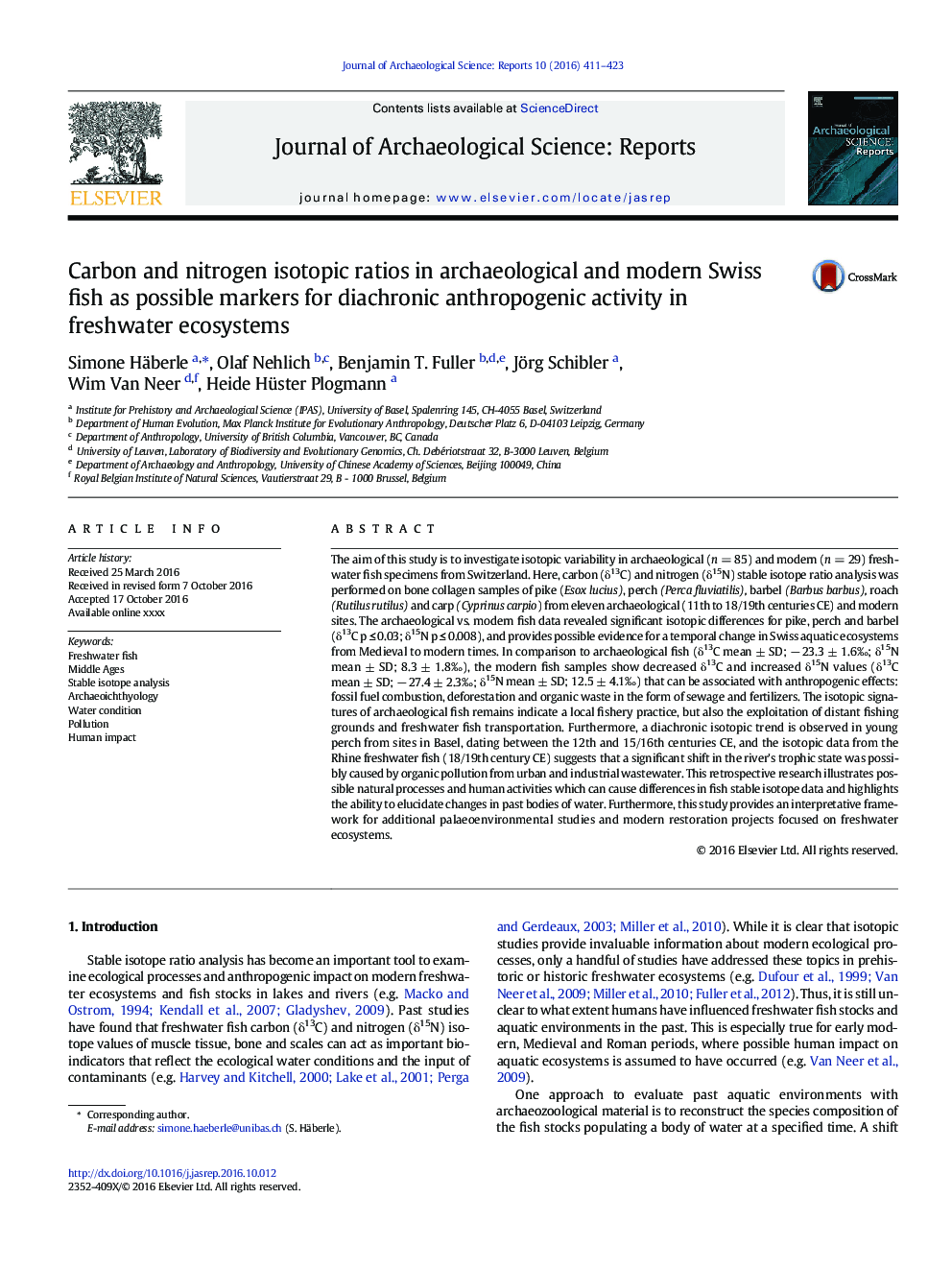| کد مقاله | کد نشریه | سال انتشار | مقاله انگلیسی | نسخه تمام متن |
|---|---|---|---|---|
| 5112253 | 1483933 | 2016 | 13 صفحه PDF | دانلود رایگان |
عنوان انگلیسی مقاله ISI
Carbon and nitrogen isotopic ratios in archaeological and modern Swiss fish as possible markers for diachronic anthropogenic activity in freshwater ecosystems
ترجمه فارسی عنوان
نسبت ایزوتوپهای کربن و نیتروژن در ماهی های باستان شناسی و مدرن سوئیس به عنوان نشانگرهای ممکن برای فعالیت های انسان شناسی تشریحی در اکوسیستم های آب شیرین
دانلود مقاله + سفارش ترجمه
دانلود مقاله ISI انگلیسی
رایگان برای ایرانیان
کلمات کلیدی
موضوعات مرتبط
علوم انسانی و اجتماعی
علوم انسانی و هنر
تاریخ
چکیده انگلیسی
The aim of this study is to investigate isotopic variability in archaeological (n = 85) and modern (n = 29) freshwater fish specimens from Switzerland. Here, carbon (δ13C) and nitrogen (δ15N) stable isotope ratio analysis was performed on bone collagen samples of pike (Esox lucius), perch (Perca fluviatilis), barbel (Barbus barbus), roach (Rutilus rutilus) and carp (Cyprinus carpio) from eleven archaeological (11th to 18/19th centuries CE) and modern sites. The archaeological vs. modern fish data revealed significant isotopic differences for pike, perch and barbel (δ13C p â¤Â 0.03; δ15N p â¤Â 0.008), and provides possible evidence for a temporal change in Swiss aquatic ecosystems from Medieval to modern times. In comparison to archaeological fish (δ13C mean ± SD; â 23.3 ± 1.6â°; δ15N mean ± SD; 8.3 ± 1.8â°), the modern fish samples show decreased δ13C and increased δ15N values (δ13C mean ± SD; â 27.4 ± 2.3â°; δ15N mean ± SD; 12.5 ± 4.1â°) that can be associated with anthropogenic effects: fossil fuel combustion, deforestation and organic waste in the form of sewage and fertilizers. The isotopic signatures of archaeological fish remains indicate a local fishery practice, but also the exploitation of distant fishing grounds and freshwater fish transportation. Furthermore, a diachronic isotopic trend is observed in young perch from sites in Basel, dating between the 12th and 15/16th centuries CE, and the isotopic data from the Rhine freshwater fish (18/19th century CE) suggests that a significant shift in the river's trophic state was possibly caused by organic pollution from urban and industrial wastewater. This retrospective research illustrates possible natural processes and human activities which can cause differences in fish stable isotope data and highlights the ability to elucidate changes in past bodies of water. Furthermore, this study provides an interpretative framework for additional palaeoenvironmental studies and modern restoration projects focused on freshwater ecosystems.
ناشر
Database: Elsevier - ScienceDirect (ساینس دایرکت)
Journal: Journal of Archaeological Science: Reports - Volume 10, December 2016, Pages 411-423
Journal: Journal of Archaeological Science: Reports - Volume 10, December 2016, Pages 411-423
نویسندگان
Simone Häberle, Olaf Nehlich, Benjamin T. Fuller, Jörg Schibler, Wim Van Neer, Heide Hüster Plogmann,
